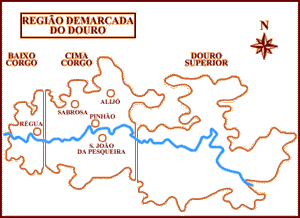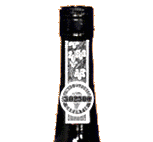www.infoportwine.com
What's Port?
28/07/01. Changed
30/12/01;07/09/02;04/01/03;06/12/03;05/03/05;02/09/06;03/01/07;15/03/08.
REGISTER
FOR NEWSLETTER.
Port is a fortified wine. For
a normal wine the fermentation, which starts after the flattening of grapes, is
let to be totally completed. That results in a dry
wine with an alcohol proof of approximately 12%.
During the production of Port the natural fermentation process is stopped at an
alcohol level of about 7% by addition of aguardente (pure wine alcohol) of
77% in a ratio of around 1 : 4. This stops the fermentation process leaving many
rest sugars and developing a sweet wine with an alcohol level between 19 and
22%. By varying the quantity of alcohol and the supply moment, Port a little
more sweet or dry develops.
Port is
produced in a legally fixed geographical
and internationally recognized area along the river Douro in North-Portugal. This
Região Demarcada do Douro was created by Marquis de Pombal in 1756.
Often the
Douro region is cited as the oldest demarcated wine region in the world. This is
however not correct. The authoritative Portuguese historian and director of the
Museu do Douro professor Gaspar Martins Pereira says on page 47 of the IVDP book
Port Wine of 2004 that two regions were demarcated earlier: Chianti in Tuscany
in 1716 and Tokay in Hungary in 1737.
However, many people stick to their views, often on the basis of the quality
of the demarcation. Luís Lopes and João Paulo Martins, for example, write in
"200 dicas sobre vinhos" (apendix to the 200th issue of the Portuguese
magazine Revista de Vinhos):
"In 1716 the Chianti region in Italy was the first geographically
demarcated wine area, but in 1756 the Douro/Porto was the first with exact
borders, own legislation and controle."
The only other place where it is allowed to deal with Port Wine is Vila Nova de
Gaia, the dual town of Oporto on the south bank of the river Douro. Here it is
allowed to store, bring up, blend and bottle Port Wine.
The products from for example South-Africa, Australia and California, which are
made to resemble Port, are therefore fake.
 The demarcated
region begins - as the crow flies - at about 60 km. east of the center of Oporto and goes on to the Spanish border. The total length is some 100 km. The
largest breadth of around 55 km. is found near Vila Flôr.
The demarcated
region begins - as the crow flies - at about 60 km. east of the center of Oporto and goes on to the Spanish border. The total length is some 100 km. The
largest breadth of around 55 km. is found near Vila Flôr.
The total area measures about 250,000 hectares of which some 42,000
hectares
with vineyards, split up into around 104,000 lots. On average owners possess
some 2.24 lots or 0.9 hectare.
The area is divided in the Baixo Corgo (below the Rio Corgo), the Cima Corgo (above
the Rio Corgo) and the Douro Superior (upper Rio Douro).
The production in the Baixo Corgo is by far the most voluminous, but generally
not the best. The best Port comes from the region round the village
of Pinhão - the Cima Corgo, and especially from
the north bank of the Douro river.
From exactly the same demarcated region also come the not fortified Douro
table wines.
The climatic
differences in the area are large. The temperature rises strongly towards
the Spanish border. And the rainfall becomes substantially less in the same
direction, although there are large differences everywhere between estates low
and high on slopes (Vila Real 1130 mm. - Pocinho 400 mm. a year).
 Quality control
in the Port industry is performed by the IVDP, the Instituto dos Vinhos do
Douro e do
Porto (formerly IVP) - www.ivdp.pt This control is a permanent process from the production to the bottling. Each lot of Port
Wine, the Standards as well as the Special Categories (see:
Files/Types 1b), has to
be approved in all laboratory tests and by the Câmara de Provadores within the norms determined
for a certain type.
Quality control
in the Port industry is performed by the IVDP, the Instituto dos Vinhos do
Douro e do
Porto (formerly IVP) - www.ivdp.pt This control is a permanent process from the production to the bottling. Each lot of Port
Wine, the Standards as well as the Special Categories (see:
Files/Types 1b), has to
be approved in all laboratory tests and by the Câmara de Provadores within the norms determined
for a certain type.
The 7 members who constitute the permanent Câmara de Provadores test some 20 lots almost
daily of which 10 are new ones. The others are earlier judged samples. By
testing these again, the consistency of the tasters is controlled
permanently.
The IVDP ratifies the end approval with the Selos de Garantia (numbered guarantee seals), the characteristic
gray strips between cork and capsule (see picture).
Port
knows many types, which can however be well divided into groups:
The quality gradings have been established in the Regulation no. 36/2005 of
the IVDP.
-
White: Standard White (5), Reserva/Reserve
White (very good - 7), Colheita White (super - 8), Aged White (super -
8).
-
Ruby style: Standard Ruby (5), (Ruby)
Reserva/Reserve (very good - 7), Crusted (super - 8), Late Bottled Vintage - LBV
(super - 8), Vintage (exceptional - 9).
-
Tawny style: Colheita (red) (super - 8),
Garrafeira (super - 8), Standard Tawny (5), Reserva/Reserve Tawny (very good -
7), Aged Tawny’s (super - 8).
For
more see: Files/Types.
Copyright
© 2001-2011 infoportwine
All rights reserved.
 The demarcated
region begins - as the crow flies - at about 60 km. east of the center of Oporto and goes on to the Spanish border. The total length is some 100 km. The
largest breadth of around 55 km. is found near Vila Flôr.
The demarcated
region begins - as the crow flies - at about 60 km. east of the center of Oporto and goes on to the Spanish border. The total length is some 100 km. The
largest breadth of around 55 km. is found near Vila Flôr. Quality control
Quality control